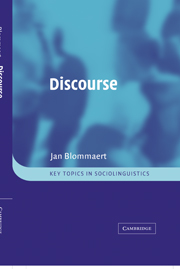Book contents
- Frontmatter
- Contents
- Preface
- Acknowledgments
- 1 Introduction
- 2 Critical Discourse Analysis
- 3 Text and context
- 4 Language and inequality
- 5 Choice and determination
- 6 History and process
- 7 Ideology
- 8 Identity
- 9 Conclusion: Discourse and the social sciences
- Notes
- Appendix: English translations of the documents in chapter 5
- Glossary
- References
- Index
5 - Choice and determination
Published online by Cambridge University Press: 02 December 2009
- Frontmatter
- Contents
- Preface
- Acknowledgments
- 1 Introduction
- 2 Critical Discourse Analysis
- 3 Text and context
- 4 Language and inequality
- 5 Choice and determination
- 6 History and process
- 7 Ideology
- 8 Identity
- 9 Conclusion: Discourse and the social sciences
- Notes
- Appendix: English translations of the documents in chapter 5
- Glossary
- References
- Index
Summary
Introduction: choice or voice?
Many traditions in the study of language in society take the creative, negotiable features of human interaction and meaning-production as their points of departure, often in the form of unspoken assumptions, which becomes apparent in the use of a terminology emphasising (rational) choice, strategic moves, preferences in interactional organisation, and so forth. When communicating, people ‘choose’ from a range of options, they ‘select’ discourse forms deemed appropriate in the particular context, and they consciously ‘plan’ the sequential moves, either by ‘choosing’ to ‘follow rules’ or by ‘flouting’ these rules. We have already mentioned H. Paul Grice's influential discussions on ‘conversational maxims’ (Grice 1975) as a case in point. A lot of conversation-analytic terminology betrays similar assumptions (e.g. ‘preference organisation’ leading to ‘preferred’ or ‘dispreferred’ moves in a conversation; see, for example, Levinson 1983: chapter 6); theories of speech comprehension such as Relevance Theory (Sperber and Wilson 1986) see understanding as a selection of context/meaning out of a range of possible alternatives; and more specific sociolinguistic theories also emphasise choice, selection, and even rational calculation as basic to human communication. This is notably the case in some models of code-selection and code-switching, where speakers are supposed to calculate the relative advantages and disadvantages of shifts into particular codes (e.g. Myers-Scotton 1993).
I am sure that some of this terminological effort to emphasise the (relative) freedom of communicating people is a matter of widely accepted conventions for social-scientific writing about people in societies.
- Type
- Chapter
- Information
- DiscourseA Critical Introduction, pp. 98 - 124Publisher: Cambridge University PressPrint publication year: 2005



